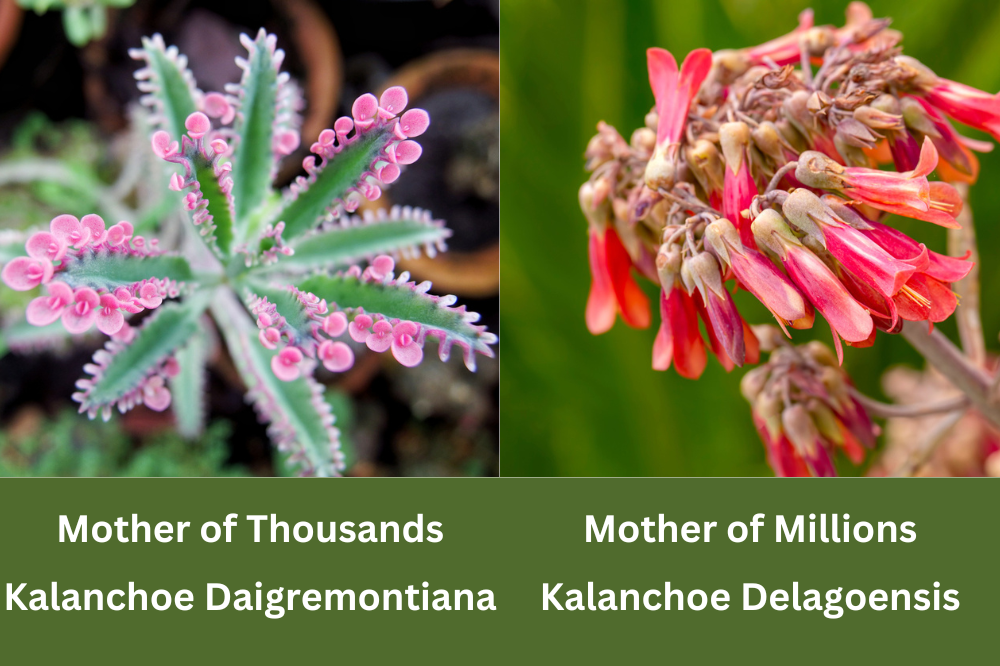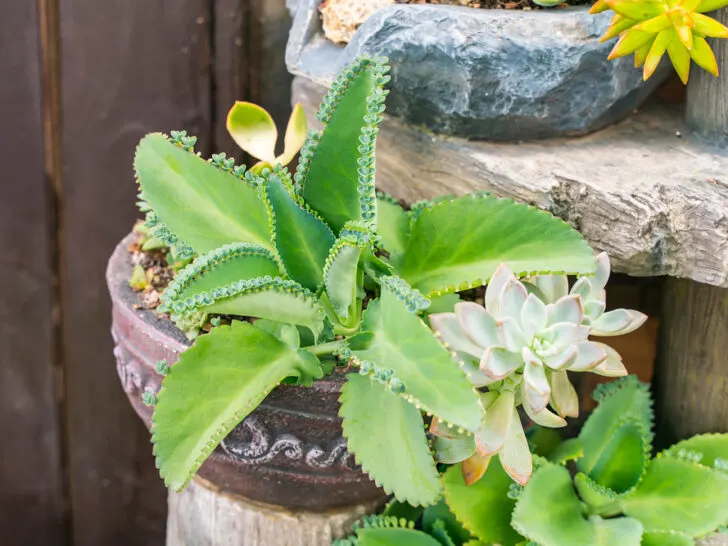
Mother of Thousands and Mother of Millions are two types of succulents from the Kalanchoe genus. The two often get confused due to the similarities of their names; however, there is an easy way to tell them apart once you know what to look for. So what is the difference between Mother of Thousands and Mother of Millions?
One difference between a Mother of Thousands succulent plant and a Mother of Millions is the leaves. A Mother of Thousands has wide, tear-shaped leaves that grow in pairs, while a Mother of Millions succulent plant has narrow, tubular leaves.
In this article, I’ll explain in great detail the key differences between the Mother of Thousands and Mother of Millions succulents. Mother of Thousands and Mother of Millions have several similarities and differences when comparing the two; let’s take a closer look.
Key Differences Between Mother of Thousands and Mother of Millions
Although these two succulents may be hard to differentiate between if you don’t know much about them, there are actually several, sometimes not so easy to spot, differences between the two.
Once you learn the aspects of each one, you will no longer confuse them. Here is a table showcasing a side-by-side comparison to familiarize you with these two succulents.
| Mother of Thousands | Mother of Millions | |
| Common Names | Mother of Thousands Mexican hat plant Alligator plant | Mother of Millions Chandelier plant Devil’s backbone |
| Botanical Name | Kalanchoe daigremontiana | Kalanchoe delagoensis |
| Plant Origin | Madagascar | Madagascar |
| Plant Type | Succulent | Succulent |
| Maximum Height | 3 ft tall (.94 Meter) | 3.3 ft tall (.99 Meter) |
| Toxicity | Poisonous to ingest. Safe to touch but could irritate sensitive skin | Poisonous when ingested Safe to touch but could irritate sensitive skin |
| Benefits | Medicinal properties | Medicinal properties |
| Growing Season | Spring/ early summer. Blooms pink flowers in the spring. Does not produce seeds | Grows year around. Blooms red-orange bell-shaped flowers in clusters in the winter. Produces seeds |
| Growth Habits | A single stalk grows straight upward towards the sun. | Tall, straight stalk with short stems sprouting from the base |
| Leaf Characteristics | Broad leaves are produced in pairs on opposite sides of stalk | Narrow leaves are not grown in pairs. |
| Plantlets | Tiny plantlets grow on the edges of the broad leaves | Tiny plantlets grow on the tips of the narrow leaves |
Let’s discuss some of the different aspects of these plants in greater detail:
Common and Botanical Names
With such similar names, it’s not surprising that many people often confuse these two Mother succulents.
Kalanchoe daigremontiana

Mother of Thousands is also known by its botanical name Kalanchoe daigremontiana. Of course, it isn’t quite as catchy or easy to remember, so you will mostly hear people referring to it as Mother of Thousands.
Due to the shape and size of its leaves, it has also been given the monikers of the Mexican hat plant and alligator plant.
Kalanchoe Delagoensis

Mother of Millions, or Kalanchoe delagoensis, is also well known by its nickname of devil’s backbone, pointing to the pattern of its leaves.
The chandelier is another nickname for the Mother of Millions plant, which has to do with how the leaves grow out of the stem in clusters.
The common names of Mother of Thousands and Mother of Millions have much to do with the fact that they reproduce plantlets at a very rapid rate.
Plant Type and Plant Origin
Mother of Thousands and Mother of Millions are succulents from the Crassulaceae family.
Mother of Thousands is native to Southwestern Madagascar, where it does most of its growth during the rainy season, which is over fairly quickly.
Mother of Millions also originates from Madagascar, where it thrives in arid conditions.
Maximum Height
In optimal conditions (usually outdoors in a hot, dry environment), these two mothers can grow approximately 3 feet tall (roughly 1 meter).
Indoors, in a more temperature and sunlight-controlled environment, they may not get quite as tall, but they can still grow beautifully.
Mother of Thousands Growing Conditions
Ideal conditions for Mother of Thousands succulents to thrive include:
- Temperatures ranging from 65 to 75 degrees Fahrenheit (18-23 degrees Celsius). Although when grown outside, they are capable of bearing intense heat.
- At least five to six hours of direct sunlight each day. Place in indirect sunlight if located in a hot climate, or else its leaves will burn.
- Succulent or cactus potting mix in a well-draining pot. Mixing in sand or pebbles helps the soil drain more efficiently, so the soil doesn’t become soggy. A clay pot is a great option, as it will absorb excess water from the soil.
- Water approximately every three weeks or as the soil becomes dry. Mother of Thousands is drought tolerant and doesn’t require watering often.
Mother of Millions Growing Conditions
Ideal conditions for Mother of Millions succulents to thrive include:
- Temperatures ranging from 65 to 95 degrees Fahrenheit (18 to 35 degrees Celsius). Freezing temperatures and slight frost can be handled for a short amount of time. However, if you live somewhere with harsh winters, you should bring them inside when temperatures drop below 40 degrees Fahrenheit (4.4 degrees Celsius).
- A minimum of four to six hours of direct sunlight every day. If taking your succulent outdoors, limit its exposure to the sun in hot climates to avoid scorching.
- Succulent or cactus well-draining potting mix is best. Adding pebbles or perlite to the soil will help with aeration, ensuring the soil doesn’t retain water.
- Irregular watering is best. Give the Mother of Millions a good soak, then allow the soil to dry out entirely before soaking the soil again.
Toxicity
Mother of Thousands vs. Mother of Millions: which mom is toxic? Well, when it comes to toxicity, both mothers are poisonous to a degree.
If you are growing one of these two beautiful succulents inside your home, take care to keep them out of reach of children and pets, as ingesting this plant can be fatal.
They are also fatal to cattle and livestock, so be sure to check their surroundings to ensure they can’t accidentally ingest them.
Poisonous Parts of Mother of Thousands
For the Mother of Thousands, the stem, leaves, and plantlets are poisonous to consume.
This is due to the succulent containing daigremontianin, a type of bufadienolide that is a highly toxic steroid capable of causing cardiac poisoning.
Poisonous Parts of Mother of Millions
For the Mother of Millions, the entire plant is also poisonous. However, the flowers on these plants are five times as toxic to ingest as the other parts of the plant.
Like the Mother of Thousands succulent, this too is due to bufadienolide.
Signs of Poisoning
If you suspect your pet or child has ingested one of these succulents, immediately call poison control and get to a doctor or veterinarian.
- Vomiting
- Diarrhea
- Heart palpitations
Touching a Mother of Thousands or Mother of Millions succulent is safe. However, you should always be careful handling them. If you have sensitive skin, both succulents could cause some irritation.
Benefits
Although the Mexican hat plant and the Chandelier plant are both toxic to ingest, they also have many excellent benefits. They are used to treat several medical needs.
Some cultures use Mother of Thousands to treat the following medical needs:
- Premature labor
- Infertility
- Inflammation
Mother of Thousands also contains the following properties:
- Anti-cancer
- Anti-tumor
- Antioxidant
- Antimicrobial
Mother of Millions is used to treat ailments such as:
- Headaches
- Boils
- Ulcers
- Dysentery
- Acute nephritis
- Bilious diarrhea
Mother of Millions contains the following properties:
- Astringent
- Febrifuge
- Diuretic
- Antiseptic
It is important to note that a certified health professional familiar with these two plants should be involved in prescribing and dosage when using Mother of Thousands and Mother of Millions for their healing properties.
Growing Season
The growing season for Mother of Thousands begins in the spring and goes into early summer. In the spring, the Mother of Thousands blooms pink flowers.
It’s best to repot and propagate in the spring as needed. This should not be done in the winter when the succulent has gone dormant.
Mother of Millions grows all year round and blooms from late winter to spring. The flowers that bloom are bell-shaped and tend to be pink or red-orange.
The best time to repot and propagate is in late summer; once the succulent is done, flowering for the season.
Growth Habits
The growing habits for these two succulents differ slightly as well.
A Mother of Thousands has a single stalk that grows straight and upward towards the sun. Its leaves grow in pairs on opposite sides of the stalk.
The Mother of Millions, however, grows one tall stalk straight up with several short stalks sprouting from the base around the central stalk.
Its leaves grow in clusters along the stems and at the very tops, giving them a chandelier look.
Leaf Characteristics and Plantlets
The leaves are the most noticeable difference between the two mothers, and each has a fascinating appeal.
Mother of Thousands Leaf Characteristics
The Mother of Thousands succulent, as previously stated, has leaves that grow in pairs along opposite sides of the stems.
What is so neat about these pairs of leaves is that the next set that grows from the stem is slightly rotated.
Each new set that grows up the stem does this, so every leaf gets an even amount of exposure to sunlight.
Another fascinating detail is how the plantlets form along the outer rim of the large leaves. They look absolutely beautiful and uniform the way they grow.
Even though the Mother of Thousands isn’t able to produce seeds, it is still capable of reproducing through its plantlets.
Characteristics of Plantlets
The plantlets are the miniature versions of the original plant that actually grow roots while still attached to its mother along the margins of the leaves. Once they fall off, it plants itself wherever it lands by rooting in the soil.
Mother of Millions Leaf Characteristics
Mother of Millions also has beautiful leaves. Its leaves are narrow and rigid and grow in clusters along the plant’s stems. They are typically bright green with a reddish/purplish tinge to the edges. Its plantlets form beautifully along the tips of these leaves.
Final Thoughts
So there you have it. It’s no longer a battle to understand the differences between these two striking succulents, and it’s much easier to tell them apart.
While there are similarities between the alligator plant and the devil’s backbone plant, they are each set apart from the other and rightfully stand on their own.
Other Articles You May Also Be Interested In
Mother of Millions Care and Propagation

